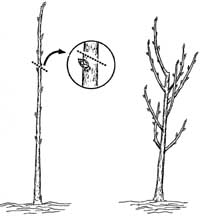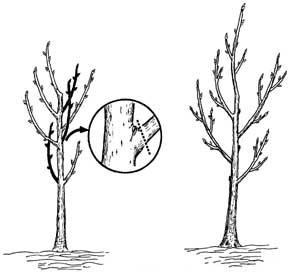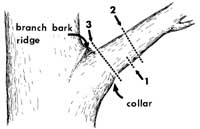by J.R. Feucht and H. Larsen1 (9/09)
Quick Facts…
- Proper pruning is an important step in ensuring healthy, strong fruit trees.
- Train fruit trees while young to avoid problems later.
- Improperly pruned or neglected trees are more subject to disease organisms and breakage from fruit loads and storms.
- Prune in late winter or early spring just before bud break.
- Wound dressings are of no benefit in pruning and can even harbor disease organisms.
 |
| Figure 1: Young whip indicating location of top cut for forcing branches (left) and growth response at end of first year (right). |
Proper training through correct pruning is important for a healthy, strong fruit tree. If a tree is properly trained from a young plant, it needs only moderate annual pruning when it reaches bearing age.
Young trees that are neglected will require removal of large branches later. This opens the tree to infectious disease organisms. Neglected trees also suffer more damage from fruit load and storm breakage than properly trained trees.
Pruning is best done in late winter or early spring just before bud break. Occasional summer and fall pruning may be needed, but keep it to a minimum. Avoid pruning in late spring and early summer when disease organisms have the best chance of invading pruning wounds.
Training a Young Tree
Fruit trees often are obtained as bare-root whips or as packaged and container-grown sizes. Bare-root whips may have few or no branches. Following planting, remove the top of the whip about 1/4 inch above a bud that is located approximately 30 to 36 inches above the soil line (see Figure 1). This will cause branching.
If branches are already present, as is usually the case with container-grown trees, remove only dead, broken or interfering branches until the tree is established. Avoid the temptation to limb the tree up right after planting. It is important to leave as much healthy growth as possible the first year to provide foliage for food production. This is needed for root establishment.
In the second year, select the branches that are well-spaced up and down the plant and leave these. Remove all other branches, particularly when they interfere with each other, arise from the trunk close to the same point, or have acute, upright crotches. These last tend to develop “included bark” as the tree grows (see Figure 2). Such branches will be weak and fail under heavy fruit loads or snows.
In subsequent years, select additional strong branches and remove weak and interfering ones. It also may be necessary to remove some lower branches that were left earlier.
When removing any branch, large or small, avoid stubs and cuts close to the trunk. As a guideline, look for a bark ridge located in the branch crotch (see Figure 2 circle insert). You also will find that most branches have a slight swelling or “collar” at their base. Avoid cutting into this because that will destroy a natural protection or boundary in the tree.
 |
| Figure 2: Prune interfering, weak or crowded branches. Stems in black are the ones to be removed (left). Make the cut outside of branch bark ridge and collar (circle insert). |
 |
| Figure 3: Use a three-step pruning method on large limbs. 1) Undercut to prevent bark stripping. 2) Remove most of limb. 3) Remove stub, making cut outside of branch bark ridge and collar. |
If at all possible, avoid cutting back tops (except in the young whips). This cuts into stems (trunks) and opens the tree to infection.
Pruning Older Trees
Avoid pruning any more than necessary. Some pruning books urge “topping” older trees to stimulate young, productive wood. This practice, however, not only leads to the development of weak shoots, but invariably opens a tree to numerous disease and wood-rotting organisms. Canker diseases such as Cytospora, common in peaches, and bacterial diseases, such as fire blight in apple and pear, are perpetuated through unnecessary and improper pruning.
Occasional thinning of branches (never the tops or branch tips) may be necessary. Undercut large branches to prevent bark-stripping when the branch falls. Then remove most of the branch weight with a cut outside of the undercut.
Make a third cut outside of the branch bark ridge and collar to remove the stub (see Figure 3). Do not make flush cuts, as has been incorrectly described for many years. Dr. Alex Shigo of the U.S. Forest Service discovered that flush cuts remove a natural boundary into the tree, thus opening the tree to infection.
Wound Dressings
It is tempting to apply a wound dressing to a pruning cut. This age-old practice, however, has been shown by several research scientists to be of no benefit to the tree and can even harbor disease organisms.
Wound dressings are sometimes desirable for aesthetics, to hide or camouflage the exposed wound. If this is the case, use the type of material in aerosol cans available at garden centers. Apply a thin coat. It should barely coat the wound, changing its color but not forming a thick, black film.
1J.R. Feucht, former Colorado State University Extension landscape plants specialist and professor, horticulture. 9/99. Reviewed by H. Larsen, Colorado State University Extension fruit pathologist and associate professor; horticulture and landscape architecture, Orchard Mesa Research Center, Grand Junction. Reviewed 9/09.
Go to top of this page.





